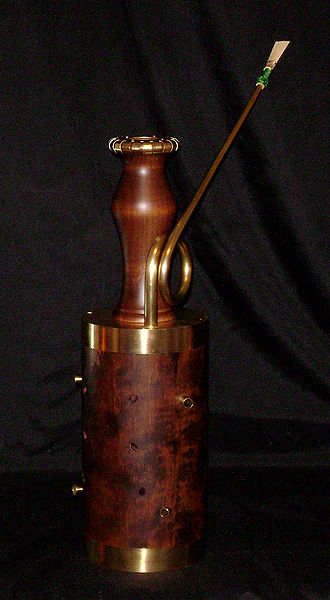Like other double reeds, the rackett produced by this instrument probably decreases as the player’s skill increases.
When I was working on my article about carbon fiber instruments, I traded emails with a researcher in musical acoustics in Australia. He saw my blog post about Papalini’s bass clarinet and said: If you’re interested in low instruments in a small package, you should take a look at the rackett.

So, here it is. It’s a Renaissance bassoon-ish instrument, and there are 9 parallel bores packed into that instrument to create the length for a low pitch. However, it looks like the fingering is pretty strange, even for a bassoon. (My band director in middle school tried to convince me to switch from the flute to the modern bassoon. In retrospect, it might have been a good idea- more opportunities for bassoon players. But two days of playing an instrument that sounded like a dying cow in my hands was probably all my family could take. Double reeds and a dizzying array of thumb keys– 8 for the left and 4 for the right, were more than I had patience for. My sister had more patience than I did in that respect, but played the oboe). But I do love the low sound of a bassoon played well, and this one could fit in your pocket.
The rackett apparently fell out of favor, possibly for practical and rather disgusting reasons. If this description from Diabolus in Musica is accurate, I can completely see why.
If you’re currently eating your lunch, stop reading now. The rackett survived as a useful pocket bass instrument until the eighteenth century. Heaven forbid that any musical instrument should retain any semblance of guts, so when the great and glorious shawm and curtal were “refined” into the emasculated oboe and bassoon, they tried it with the rackett as well, but came unstuck. To get a “polite” tone, they had to narrow the bore, which was already narrow. That would be fine, except that they tended to play the things after dinner, and bits of semi-chewed food would find their way down the reed and into the narrow bits, eventually clogging the instrument solid. Now, unclogging a rackett is a technician’s job, so the beast would be put on a shelf until the local instrument maker could look at it. If that shelf happened to be in the sun, or above a fireplace, ideal breeding conditions for bacteria would ensue, and pressure would build up in the clogged tubes. There are a supposedly a number of attested cases of shelved racketts exploding without warning, emitting splinters and noxious odours in equal quantity.
Blech!! I’d like to hear one, but only before dinner.

The fingering for the Baroque rackett (pictured in your post) is actually fairly similar to a modern alto recorder in F throughout much of its range (in a different octave, of course), though things get a little weird at the extremes of the range.
If you haven’t found any examples of racketts being played yet, this page has a few notes played upon a Renaissance rackett, and this YouTube video demonstrates what a Baroque rackett sounds like (at least, in the hands of an unskilled player).
Thanks, Godfrey. I hadn’t heard these.
Here’s a really great recording of some racketts.
https://youtu.be/HGI4zG-Zddw